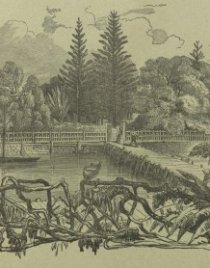
Timber Getting
Early references to the original cedar forests journeying up the Hunter River by Cherylanne Bailey
STOCKTON by WJ Goold
” STOCKTON, the oldest suburb of Newcastle, can trace its origin back to the day when the Hunter River was discovered by Lieutenant John Shortland, for he landed on three parts of the peninsula.
Its first title was “Pirate’s Point”, due to the fact that in 1800 a gang of escaping convicts, who had seized the small vessel “Norfolk” in Broken Bay and were making their way northwards, were wrecked upon the point of the peninsula.
The early cedar parties secured valuable timber along the river bank here, and Hugh Meehan, in 1799, had his first saw pit on the North Shore.”
“…When Lachlan Macquarie stood on top of the hill in 1808 he saw stretching across the harbour, Pirate’s Point (now Stockton) covered as far as the eye could see with a dense forest, with, perhaps, a thin column of smoke arising here and there, denoting a black’s camp.” (2)
Extract of relevant pages of JW Turner’s Manufacturing in Newcastle, 1801-1900
In Stockton’s early years but long after the cedar trees had been cut down from the foreshore, there was a ballast wharf or jetty at the eastern end (harbour side) and efforts were made to build a breakwater with ship’s ballast. (3) From the establishment of a permanent settlement until 1822 the extraction of timber was carried on exclusively by convict parties who travelled up the rivers of the Hunter Valley by boat in order to spend a month or more at their work. As cutting proceeded, the journeys became longer but the location of the industry was always dependent upon the river for transport. Each party of thirty labourers and two overseers was tasked to cut 100 logs. twelve to sixteen feet in length, drag them to the river and form them into rafts to be floated downstream.
As the journey depended upon the tides and took about eight days, a shelter had to be erected on each raft for the timber getters. Boats accompanied the rafts to facilitate their passage and when Newcastle was reached every available boat was brought into play to secure the hard won timbers. Major George Druitt, the Chief Engineer of New South Wales, believed that the work of these gangs was the hardest in the colony but Commandant Morisset thought that they preferred it. Perhaps it was a relief to escape from Newcastle’s bell-dominated routine of musters, inspections and work. During the years for which records are available, from l805 until 1820. 7,164 cedar logs equivalent to almost one and a half million superficial feet of timber were shipped to Sydney.
The busiest years were 1808, 1811 and 1820. when the output of logs exceeded 100.000 superficial feet. Timber valued at £22,412 was shipped to Sydney between 1805 and 1820 apart from the considerable quantities used in construction in the settlement. All of this was extracted by the Crown, which also used most of the timber sent to the capital, but private traders played a significant part, handling timber valued at £5,464. The disappearance of private traders after 1816 has been attributed by Hainsworth to the greater accessibility of timber from other districts. particularly the Shoalhaven River, but it may be that they could obtain timber more cheaply by cutting it themselves.
HHowever the scarcity of certain timbers in the Hunter Valley where the government parties were so active may also have been inftuential. In contrast the government harvest of timber was greatest towards the end of the convict settlement. More logs had been obtained in some earlier years but the greater amount of labour available as the population increased and the growing. need of government in Sydney produced timber valued at £2,322 in 1819. the first time the total value of timber shipments from the Hunter had reached this level since 1808.There is no doubt that considerable quantities of marketable timbers remained in the Hunter area when the penal settlement was closed, but the most accessible stands had been exhausted.
As early as 1811 the commandant was instructed to enforce the full price for cedar because of the distance it was having to be transported and in 1813 Governor Macquarie forbade further shipments until a source of good quality was discovered. Two years later, there were several hundred logs on the beach but they did not satisfy Macquarie because very few could be squared at more than thirty inches. On other occasions special measures had to be taken to meet demands from Headquarters as in 1810 when the Lady Nelson visited Lake Macquarie to obtain rosewood or when the Sydney shipwrights ordered twenty five pieces of ‘crooked honeysuckle’ which was exhausted on the Hunter River by 1818
The output of sawn timber of all kinds was. determined by the supply of skilled labour. Sawyers were much sought after in the colony and there were times when even the local demand for sawn timber could not be met. Commandants had to be on guard lest spongelike Sydney Town absorb the skilled workers needed by the penal establishment. This was particularly so in Wallis’s time when a large number of new buildings was constructed, including a gaol and church, though there were only three pairs of sawyers in the settlement and their presence was being queried by the Governor’s Secretary
